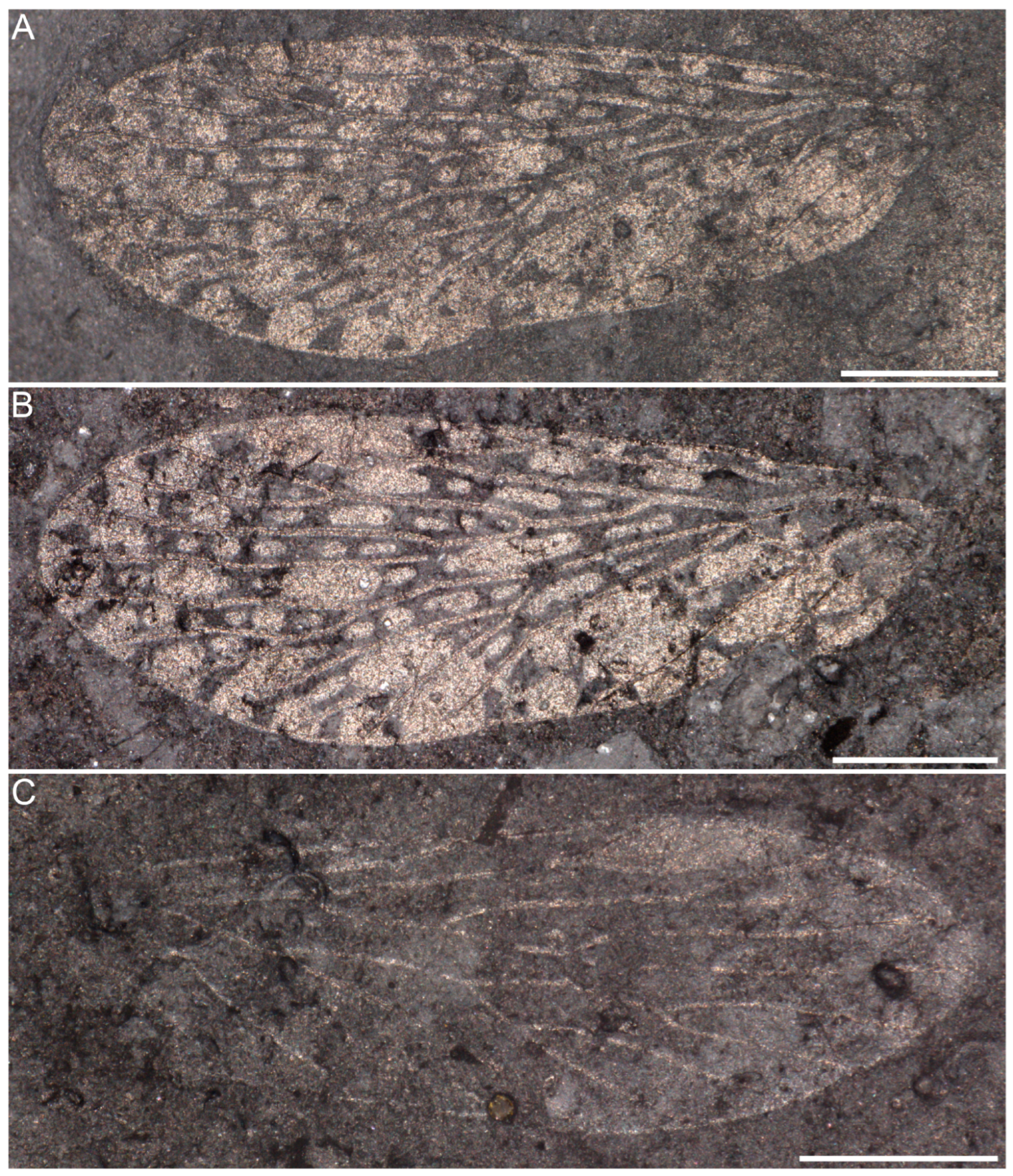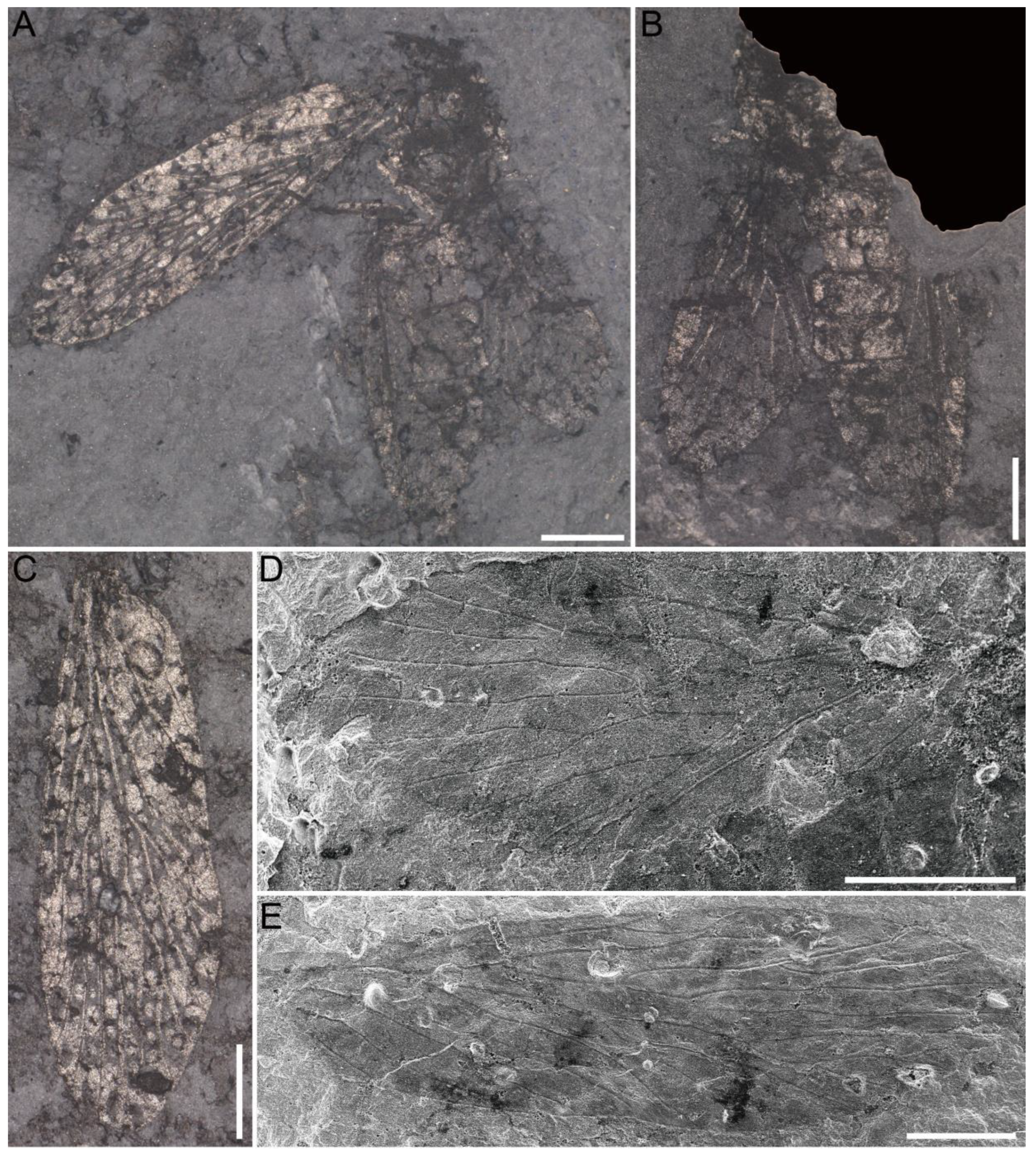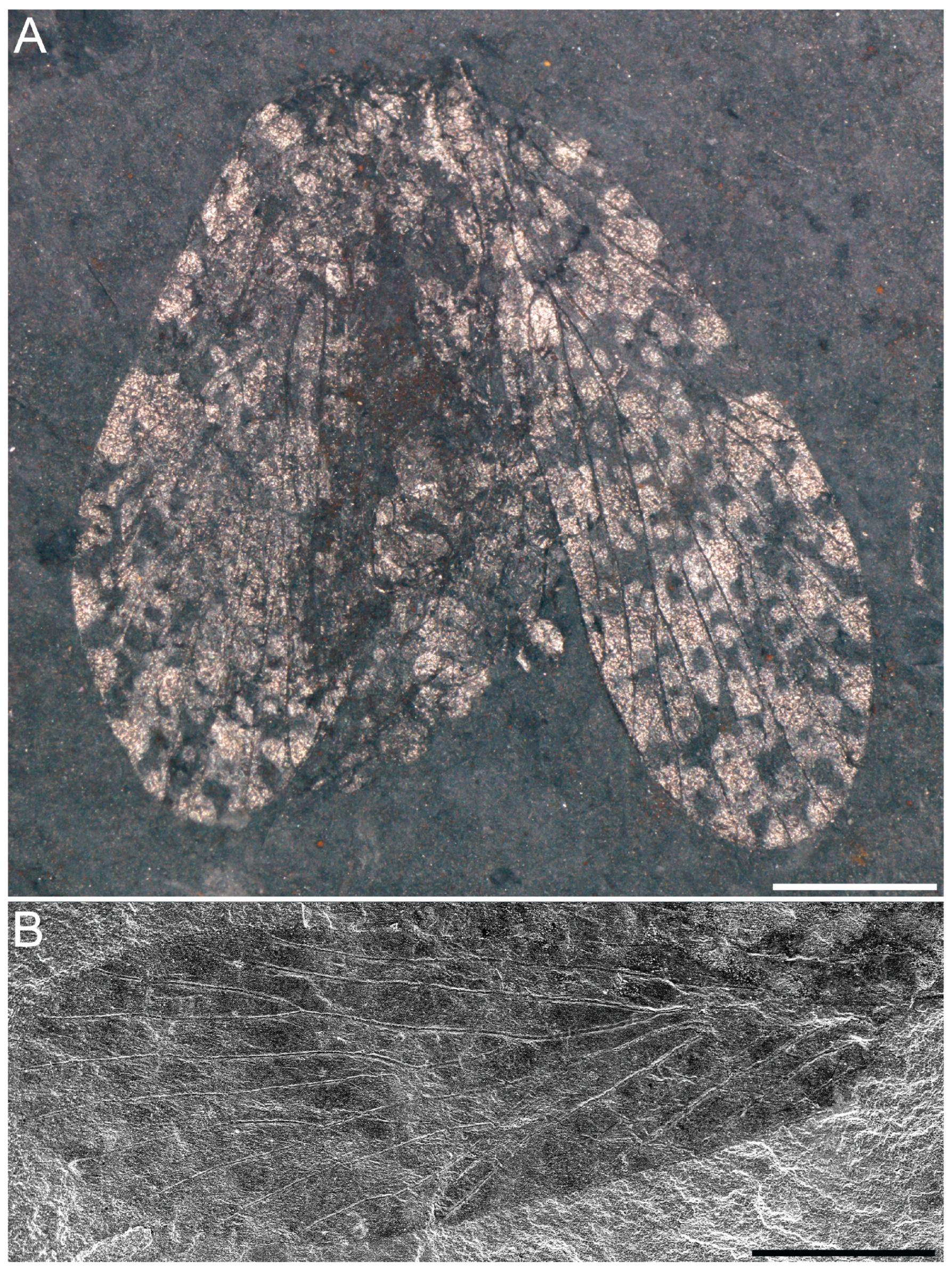Two New Species of Mesochorista (Insecta, Mecoptera, Permochoristidae) from the Guadalupian Yinping Formation of Chaohu, Eastern China †
Simple Summary
Abstract
1. Introduction
2. Materials and Methods
3. Systematic Paleontology
- Paratypes, NIGP205289 (Figure 2A and Figure 3D), 5.5 mm long, 2.0 mm wide (L/W = 2.8), humeral vein present; Sc3 present; Rs1+2 2.2 × length of Rs3+4; M1+2 5.3 × length of M3+4, M4 shorter than M4a and M4b; one crossvein between Rs2 and Rs3, and between Rs3 and Rs4, two crossveins between Rs and M, crossvein m-cua connecting basal M4 and CuA; NIGP205290 (Figure 2B and Figure 3E), 5.5 mm long, 2.0 mm wide (L/W = 2.8), Sc3 undetected, crossvein sc1-r1 moderately long, Rs1+2 2.2 × length of Rs3+4, M1+2 5.0 × length of M3+4, three crossveins connecting Rs and M, crossvein m-cua connecting basal M4 and CuA; NIGP205291 (Figure 3F), 6.4 mm long, 2.0 mm wide (L/W = 3.2), wing relatively elongated, Sc2 relatively long, Sc3 undetected, Rs1+2 2.6 × length of Rs3+4, M1+2 5.4 × length of M3+4, M2 relatively short, M4 shorter than M4a, one crossvein connecting Rs3 and Rs4, crossvein m-cua connecting basal M4 and CuA; NIGP205292 (Figure 3G), 5.4 mm long, 1.9 mm wide (L/W = 2.8), Sc2 relatively short, Sc3 at level of Rs origin, Rs1+2 2.5 × length of Rs3+4, M1+2 5.6 × length of M3+4, M4 stem longer than M4a and M4b, sc1-r1 moderately short, one crossvein between Rs1 and Rs2, and mid Rs3 and Rs4, m-cua connected basal M4 and CuA; NIGP205293 (Figure 3H), 4.8 mm long, 2.0 mm wide (L/W = 2.8), Sc1 moderately short, Sc2 very short, Sc3 undetected, costal area narrow, Rs1+2 1.7 × length of Rs3+4, M1+2 3.0 × length of M3+4, M2 fork rounded; NIGP205294, 5.0 mm long (as preserved), 1.8 mm wide, Sc moderately short, Sc3 undetected, Rs1+2 2.1 × length of Rs3+4, M1+2 5.0 × length of M3+4, M4 longer than M4a and M4b, sc1-r1 short, one crossvein connecting Rs3 and Rs4, two crossveins connecting Rs and M, m-cua connecting basal M4 and CuA; NIGP205295 (Figure 3C), 4.2 mm long, 1.6 mm wide, hindwing, R1a forming the boundary of pterostigma basal; Rs1+2 2.0 × length of Rs3+4, M1+2 2.7 × length of M3+4, two straight anal veins present; NIGP205296, 4.9 mm long (as preserved), 1.7 mm wide, wing deformed in middle part, Sc3 proximal to origin of Rs.


4. Discussion
Author Contributions
Funding
Institutional Review Board Statement
Informed Consent Statement
Data Availability Statement
Acknowledgments
Conflicts of Interest
References
- Rasnitsyn, A.P.; Aristov, D.S.; Gorochov, A.V.; Rowland, J.M.; Sinitshenkova, N.D. Important new insect fossils from Carrizo Arroyo and the Permo-Carboniferous faunal boundary. New Mex. Mus. Nat. Hist. Sci. Bull. 2004, 25, 215–246. [Google Scholar]
- Wang, J.S.; Hua, B.Z. A Color Atlas of the Chinese Mecoptera; Springer Nature: Berlin, Germany, 2022; p. 354. [Google Scholar]
- Zhang, Y.J.; Lin, X.D.; Shih, C.K.; Ren, D.; Zhao, Y.Y. First report of detailed mouthpart structures of Orthophlebiidae (Insecta: Mecoptera) from mid-Cretaceous amber of northern Myanmar. Cretac. Res. 2023, 144, 105443. [Google Scholar] [CrossRef]
- Grimaldi, D.; Engel, M.S. Evolution of the Insects; Cambridge University Press: New York, NY, USA, 2005. [Google Scholar]
- Lian, X.N.; Cai, C.Y.; Huang, D.Y. The early assemblage of Middle–Late Jurassic Yanliao biota: Checklist, bibliography and statistical analysis of described taxa from the Daohugou beds and coeval deposits. Palaeoentomology 2021, 4, 095–136. [Google Scholar] [CrossRef]
- Tillyard, R.J. Upper Permian Insects of New South Wales. II. The Orders Mecoptera, Paramecoptera and Neuroptera. Proc. Linn. Soc. N. S. Wales 1926, 51, 265–282. [Google Scholar]
- Tillyard, R.J. Some new Permian insects from Belmont, NSW in the collection of Mr. John Mitchell. Proc. Linn. Soc. N. S. Wales 1922, 47, 279–292. [Google Scholar]
- Tillyard, R.J. Permian and Triassic insects from New South Wales, in the collection of Mr. John Mitchell. Proc. Linn. Soc. N. S. Wales 1917, 42, 720–756. [Google Scholar]
- Carpenter, F.M. The Lower Permian insects of Kansas. Part I. Introduction and the order Mecoptera. Bull. Mus. Comp. Zool. 1930, 52, 69–101. [Google Scholar]
- Martynova, O.M. Permian Mecoptera from Chekarda and Kargala. Izv. Akad. Nauk SSSR Seriia Biol. 1942, 1–2, 133–149. [Google Scholar]
- Pinto, I.D. Permian insects from the Paraná Basin, South Brazil I. Mecoptera. Rev. Bras. Geociências 1972, 2, 105–116. [Google Scholar]
- Riek, E.F. New Upper Permian insects from Natal, South Africa. Ann. Natal Mus. 1976, 22, 755–789. [Google Scholar]
- Srivastava, A.K. Insect and insect activities in Permian Gondwana of India. Permophiles 1997, 30, 17. [Google Scholar]
- Bashkuev, A.S. Diverse new taxa of the enigmatic family Permotanyderidae (Insecta: Mecoptera), with notes on the phylogeny of Aneuretopsychina (long-proboscid scorpionflies). Zootaxa 2022, 5222, 545–577. [Google Scholar] [CrossRef]
- Lian, X.N.; Cai, C.Y.; Huang, D.Y. Sinoagetopanorpidae fam. nov., a New Family of Scorpionflies (Insecta, Mecoptera) from the Guadalupian of South China. Insects 2023, 14, 96. [Google Scholar] [CrossRef]
- Tillyard, R.J. The panorpoid complex in the British Rhaeticand Lias. Foss. Insects 1933, 3, 15–59. [Google Scholar]
- Ansorge, J. Revision der liassischen “Permochoristidae” (Stammgruppenvertreter der Antliophora = Mecoptera + Diptera). Stud. Dipterol. 1995, 2, 21–26. [Google Scholar]
- Lian, X.N.; Cai, C.Y.; Huang, D.Y. New discovery of Permochoristidae (Insecta, Mecoptera) from the Guadalupian of Chaohu City, Anhui Province, China. Acta Palaeontol. Sin. 2022, 61, 472–478. [Google Scholar]
- Lian, X.N.; Cai, C.Y.; Huang, D.Y. The earliest known species of Permeca (Insecta, Mecoptera, Permochoristidae) from the late Guadalupian Yinping Formation of China. Palaeoentomology 2022, 5, 395–399. [Google Scholar] [CrossRef]
- Minet, J.; Huang, D.Y.; Wu, H.; Nel, A. Early Mecopterida and the systematic position of the Microptysmatidae (Insecta: Endopterygota). Ann. Société Entomol. Fr. 2010, 46, 262–270. [Google Scholar] [CrossRef][Green Version]
- Bashkuev, A.S.; Sukatsheva, I.D. New species of Kamopanorpa Martynov from the Permian of South Siberia with comments on the systematic position of Microptysmatidae (Protomeropina = Permotrichoptera). Palaeoentomology 2021, 4, 453–461. [Google Scholar] [CrossRef]
- Novokshonov, V.G. Early Evolution of Scorpionflies (Insecta: Panorpida); Nauka: Moscow, Russia, 1997. [Google Scholar]
- Tillyard, R.J. Descriptions of the fossil Insects, in Mesozoic and Tertiary insects of Queensland and New South Wales. Qld. Geol. Surv. 1916, 253, 1–60. [Google Scholar]
- Willmann, R. Zur systematischen Stellung mesozoischer und tertiärer Mecopteren einschließlich Eoses triassica Tindale (angeblich Lepidoptera) (Insecta, Holometabola). Paläontologische Z. 1984, 53, 231–246. [Google Scholar] [CrossRef]
- Guo, X.R.; Hong, Y.C. New genus and species of Permochoristidae Tillyard (Insecta, Mecoptera) from the Middle Triassic Tongchuan Formation, Shaanxi Province, China. Acta Zootaxonomica Sin. 2003, 28, 712–715. [Google Scholar]
- Martynova, O.M. Order Mecoptera. In Paleozoic Insects from the Kuznetsk Basin; Rohdendorf, B.B., Becker-Migdisova, E.E., Martynova, O.M., Sharov, A.G., Eds.; Publishing House of the Academy of Sciences of the USSR: Moscow, Russia, 1961; Volume 88, pp. 487–592. [Google Scholar]
- Martynova, O.M. Materials on the evolution of the Mecoptera. Bull. Acad. Sci. USSR 1948, 14, 1–76. [Google Scholar]
- Kopylov, D.; Rasnitsyn, A.; Aristov, D.; Bashkuev, A.; Bazhenova, N.; Dmitriev, V.; Gorochov, A.; Ignatov, M.; Ivanov, V.; Khramov, A.; et al. The Khasurty fossil insect lagerstätte. Paleontol. J. 2020, 54, 1221–1394. [Google Scholar] [CrossRef]
- Ren, D.; Lu, L.; Guo, Z.; Ji, S. Faunae and Stratigraphy of Jurassic-Cretaceous in Beijing and the Adjacent Areas; Geological Publishing House: Beijing, China, 1995. [Google Scholar]
- Novokshonov, V.G. Permian scorpionflies (Insecta, Panorpida) on the family Permochoristidae. Paleontol. Zh. 1995, 1, 64–74. [Google Scholar]
- Riek, E.F. Fossil mecopteroid insects from the Upper Permian of New South Wales. Rec. Aust. Mus. 1953, 23, 55–87. [Google Scholar] [CrossRef]
- Novokshonov, V.G. Order Panorpida Latreille, 1802. In History of Insects; Rasnitsyn, A.P., Quicke, D.L.J., Eds.; Kluwer Academic Press: Dordrecht, The Netherlands, 2002; pp. 194–198. [Google Scholar]
- Lian, X.N.; Cai, C.Y.; Huang, D.Y. New species of permochoristids (Insecta, Mecoptera) from the late Middle Triassic Tongchuan entomofauna in Shaanxi Province, northwestern China. Hist. Biol. 2022, 35, 2005–2010. [Google Scholar] [CrossRef]


Disclaimer/Publisher’s Note: The statements, opinions and data contained in all publications are solely those of the individual author(s) and contributor(s) and not of MDPI and/or the editor(s). MDPI and/or the editor(s) disclaim responsibility for any injury to people or property resulting from any ideas, methods, instructions or products referred to in the content. |
© 2025 by the authors. Licensee MDPI, Basel, Switzerland. This article is an open access article distributed under the terms and conditions of the Creative Commons Attribution (CC BY) license (https://creativecommons.org/licenses/by/4.0/).
Share and Cite
Lian, X.; Cai, C.; Feng, Z.; Huang, D. Two New Species of Mesochorista (Insecta, Mecoptera, Permochoristidae) from the Guadalupian Yinping Formation of Chaohu, Eastern China. Insects 2025, 16, 1130. https://doi.org/10.3390/insects16111130
Lian X, Cai C, Feng Z, Huang D. Two New Species of Mesochorista (Insecta, Mecoptera, Permochoristidae) from the Guadalupian Yinping Formation of Chaohu, Eastern China. Insects. 2025; 16(11):1130. https://doi.org/10.3390/insects16111130
Chicago/Turabian StyleLian, Xinneng, Chenyang Cai, Zhuo Feng, and Diying Huang. 2025. "Two New Species of Mesochorista (Insecta, Mecoptera, Permochoristidae) from the Guadalupian Yinping Formation of Chaohu, Eastern China" Insects 16, no. 11: 1130. https://doi.org/10.3390/insects16111130
APA StyleLian, X., Cai, C., Feng, Z., & Huang, D. (2025). Two New Species of Mesochorista (Insecta, Mecoptera, Permochoristidae) from the Guadalupian Yinping Formation of Chaohu, Eastern China. Insects, 16(11), 1130. https://doi.org/10.3390/insects16111130







